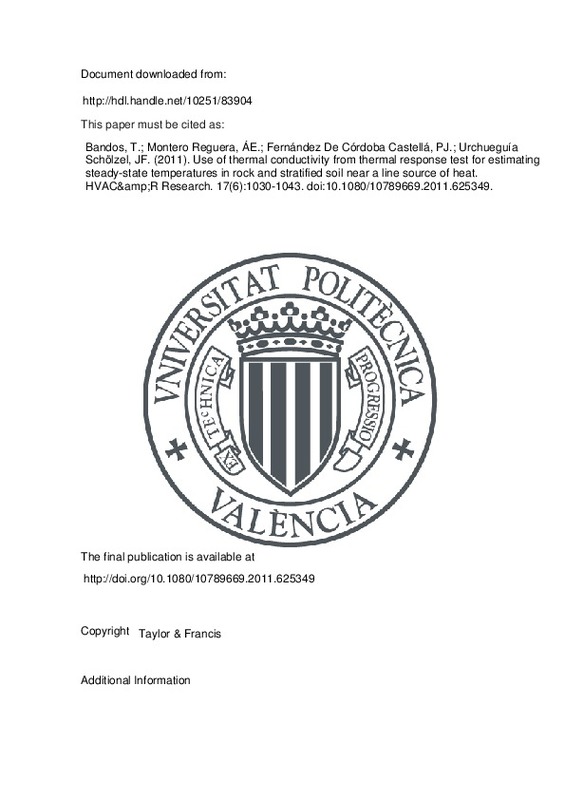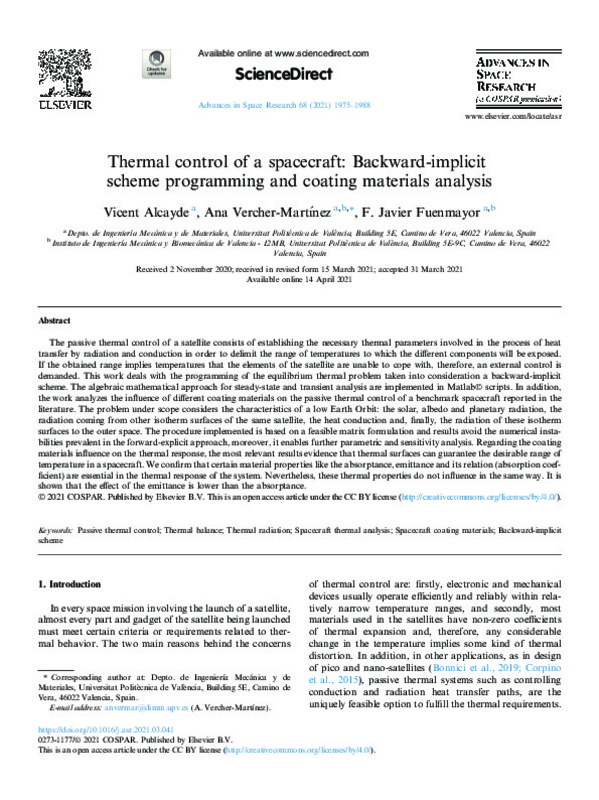JavaScript is disabled for your browser. Some features of this site may not work without it.
Buscar en RiuNet
Listar
Mi cuenta
Estadísticas
Ayuda RiuNet
Admin. UPV
Use of thermal conductivity from thermal response test for estimating steady-state temperatures in rock and stratified soil near a line source of heat
Mostrar el registro sencillo del ítem
Ficheros en el ítem
| dc.contributor.author | Bandos, Tetyana
|
es_ES |
| dc.contributor.author | Montero Reguera, Álvaro Enrique
|
es_ES |
| dc.contributor.author | Fernández de Córdoba Castellá, Pedro José
|
es_ES |
| dc.contributor.author | Urchueguía Schölzel, Javier Fermín
|
es_ES |
| dc.date.accessioned | 2017-06-28T07:30:53Z | |
| dc.date.available | 2017-06-28T07:30:53Z | |
| dc.date.issued | 2011 | |
| dc.identifier.issn | 1078-9669 | |
| dc.identifier.uri | http://hdl.handle.net/10251/83904 | |
| dc.description.abstract | This article addresses the influence of anisotropy of the ground on steady-state temperature in the surroundings of vertical borehole and effective thermal conductivity measured by a field thermal response test. This is a key parameter in the design of ground coupled heat pumps to heat and cool buildings. First, this article provides a brief overview of the current technique of estimating thermal conductivity from data obtained in a thermal response test based on predictions for temperature from a line source of heat in an isotropic ground. Then, the analytical solutions to the isotropic model for the ground are used to obtain the solutions to the anisotropic model for stratified medium. In addition, the article provides a new analytical exact solution for temperatures around a finite line source of heat penetrating anisotropic semi-infinite medium, in which the angle between the ground surface and the sedimentary strata is arbitrary. Approximate expressions for the temperature evolution during the test and for the steady-state temperature are presented. Such approximate expressions are also given for integral mean temperature for two special orientations of the strata. The limitations of the finite line source method in stratified medium and recommendations for layout of multiple vertical or horizontal ground coupled heat exchangers or waste canisters in repository rock are discussed. Copyright © 2011 American Society of Heating, Refrigerating and Air-Conditioning Engineers. | es_ES |
| dc.description.sponsorship | This paper has been supported by the European Union Commission under project 043340, and Geotrainet-IEE/07/581; the Spanish Ministry of Education and Science under projects "Modelado y simulacion de sistemas energeticos complejos" (Programa Ramon y Cajal 2005) and ENE2008-00599/ CON; by the Government of Valencia under project GV/2008/292; and by PAID-06-09/2734. | en_EN |
| dc.language | Inglés | es_ES |
| dc.publisher | Taylor & Francis | es_ES |
| dc.relation.ispartof | HVAC&R Research | es_ES |
| dc.rights | Reserva de todos los derechos | es_ES |
| dc.subject | Anisotropic models | es_ES |
| dc.subject | Approximate expressions | es_ES |
| dc.subject | Effective thermal conductivity | es_ES |
| dc.subject | Exact solution | es_ES |
| dc.subject | Ground coupled heat pump | es_ES |
| dc.subject | Ground surfaces | es_ES |
| dc.subject | Isotropic models | es_ES |
| dc.subject | Key parameters | es_ES |
| dc.subject | Line sources | es_ES |
| dc.subject | Mean temperature | es_ES |
| dc.subject | Sedimentary strata | es_ES |
| dc.subject | Semi-infinite medium | es_ES |
| dc.subject | Special orientation | es_ES |
| dc.subject | Steady-state temperature | es_ES |
| dc.subject | Stratified medium | es_ES |
| dc.subject | Stratified soil | es_ES |
| dc.subject | Temperature evolution | es_ES |
| dc.subject | Thermal response test | es_ES |
| dc.subject | Vertical borehole | es_ES |
| dc.subject | Waste canisters | es_ES |
| dc.subject | Anisotropic media | es_ES |
| dc.subject | Anisotropy | es_ES |
| dc.subject | Thermal conductivity | es_ES |
| dc.subject.classification | MATEMATICA APLICADA | es_ES |
| dc.subject.classification | MAQUINAS Y MOTORES TERMICOS | es_ES |
| dc.subject.classification | FISICA APLICADA | es_ES |
| dc.title | Use of thermal conductivity from thermal response test for estimating steady-state temperatures in rock and stratified soil near a line source of heat | es_ES |
| dc.type | Artículo | es_ES |
| dc.identifier.doi | 10.1080/10789669.2011.625349 | |
| dc.relation.projectID | info:eu-repo/grantAgreement/UPV//PAID-06-09-2734/ | es_ES |
| dc.relation.projectID | info:eu-repo/grantAgreement/EC/FP6/43340/EU/Engineered modular bacterial hydrogen photo-production of hydrogen/BIOMODULARH2 | es_ES |
| dc.relation.projectID | info:eu-repo/grantAgreement/MICINN//ENE2008-00599/ES/MODELADO, SIMULACION Y VALIDACION EXPERIMENTAL DE LA TRANSFERENCIA DE CALOR EN EL ENTORNO DE LA EDIFICACION/ | es_ES |
| dc.relation.projectID | info:eu-repo/grantAgreement/GVA//GV%2F2008%2F292/ | es_ES |
| dc.rights.accessRights | Abierto | es_ES |
| dc.contributor.affiliation | Universitat Politècnica de València. Instituto Universitario de Matemática Pura y Aplicada - Institut Universitari de Matemàtica Pura i Aplicada | es_ES |
| dc.contributor.affiliation | Universitat Politècnica de València. Escuela Técnica Superior de Ingenieros Industriales - Escola Tècnica Superior d'Enginyers Industrials | es_ES |
| dc.description.bibliographicCitation | Bandos, T.; Montero Reguera, ÁE.; Fernández De Córdoba Castellá, PJ.; Urchueguía Schölzel, JF. (2011). Use of thermal conductivity from thermal response test for estimating steady-state temperatures in rock and stratified soil near a line source of heat. HVAC&R Research. 17(6):1030-1043. https://doi.org/10.1080/10789669.2011.625349 | es_ES |
| dc.description.accrualMethod | S | es_ES |
| dc.relation.publisherversion | http://doi.org/10.1080/10789669.2011.625349 | es_ES |
| dc.description.upvformatpinicio | 1030 | es_ES |
| dc.description.upvformatpfin | 1043 | es_ES |
| dc.type.version | info:eu-repo/semantics/publishedVersion | es_ES |
| dc.description.volume | 17 | es_ES |
| dc.description.issue | 6 | es_ES |
| dc.relation.senia | 206218 | es_ES |
| dc.contributor.funder | Ministerio de Ciencia e Innovación | es_ES |
| dc.contributor.funder | European Commission | es_ES |
| dc.contributor.funder | Generalitat Valenciana | es_ES |
| dc.contributor.funder | Universitat Politècnica de València | es_ES |







![[Cerrado]](/themes/UPV/images/candado.png)


